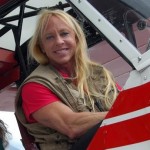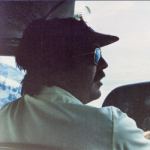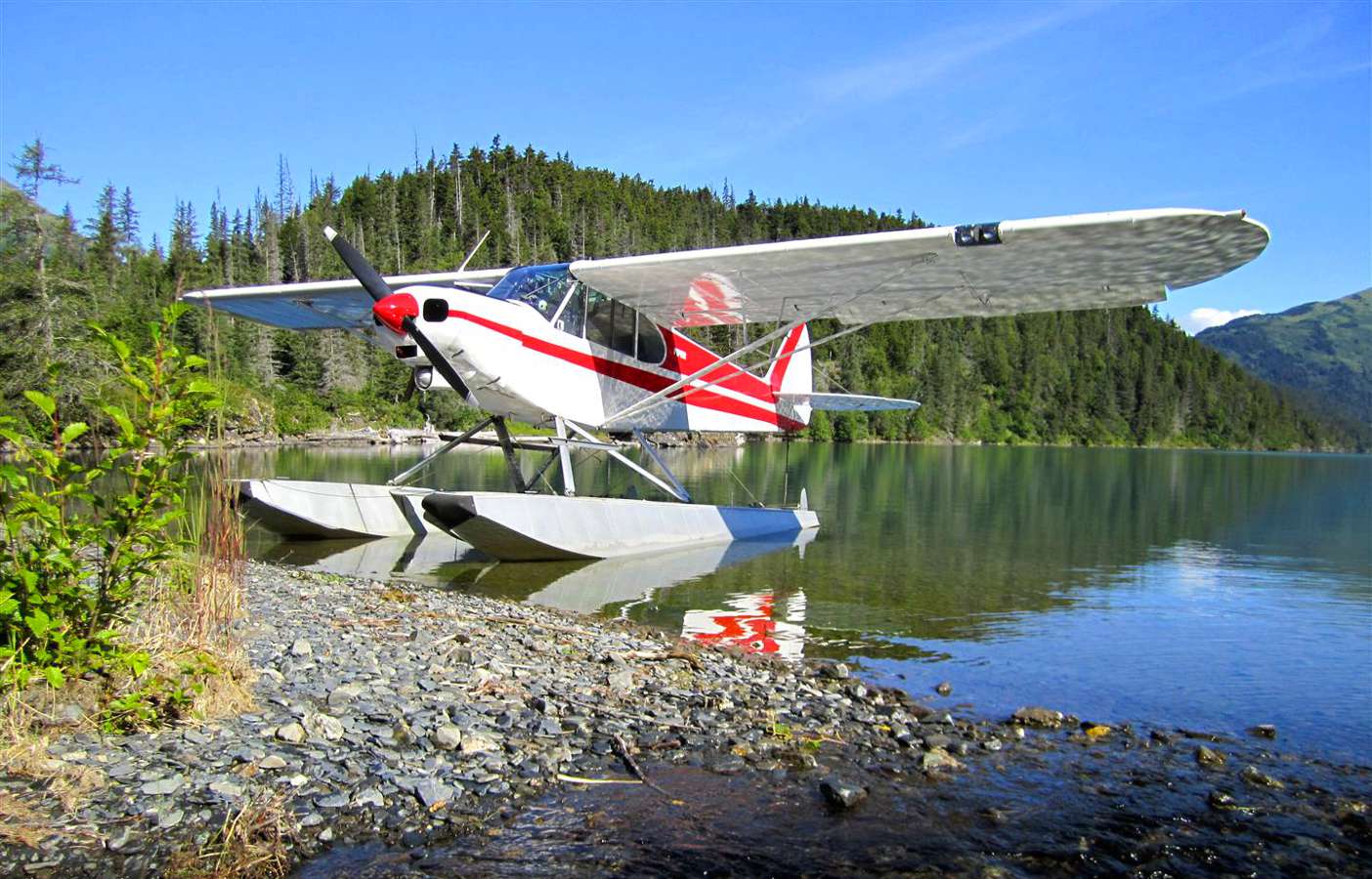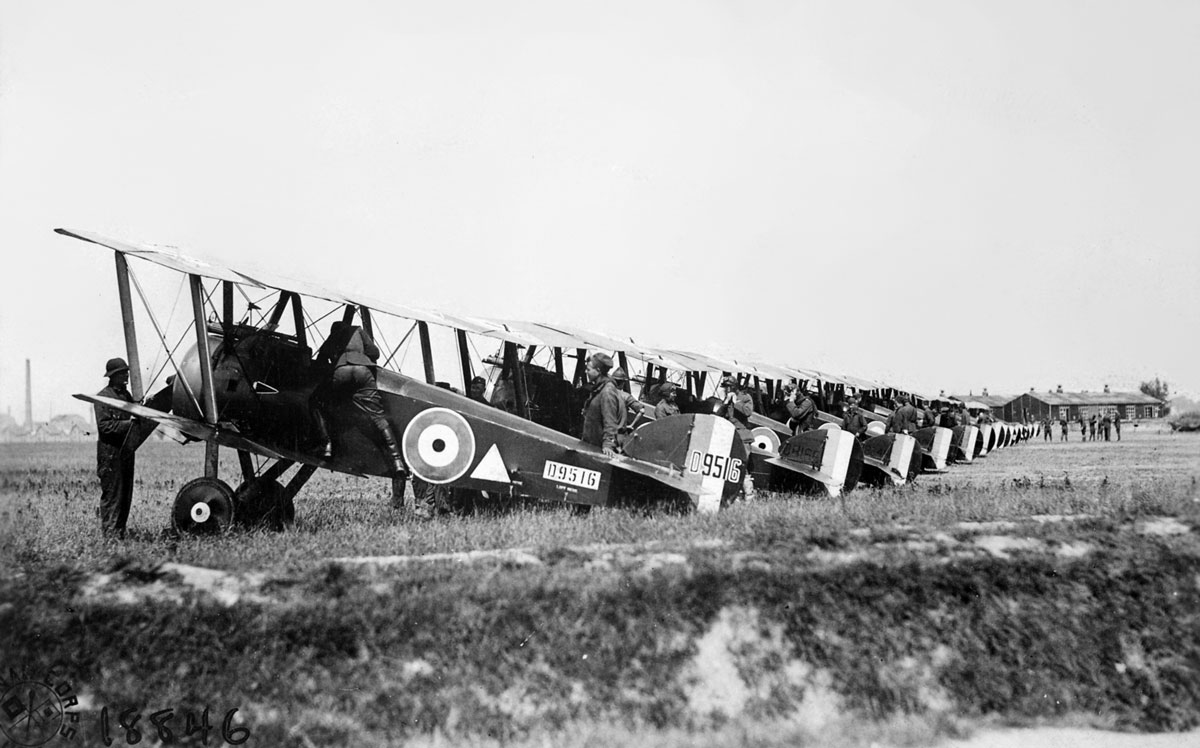Piper PA-18 Super Cub: The Shortfield Takeoff and Landing Champion
By R.K. Dick Williams with Crista Worthy

Mention the words “bush plane” and the image that pops into most pilot’s minds is the venerable Piper PA-18 Super Cub. This go-anywhere workhorse seems to have the perfect combination of power, handling, and ruggedness, hence its ubiquity in Alaska, the Yukon, Idaho and anywhere else bush pilots operate year after year. They’re not all working airplanes, though. A simple trip to the Johnson Creek, Idaho airstrip during the annual SuperCub.org fly-in proves that the PA-18 remains a popular choice among recreational pilots too—normally well over 100 Super Cubs fly in. Most of these owners like to fly the backcountry for camping, fishing or just “bagging strips” and wouldn’t be considered as working bush pilots.
The PA-18’s ability to take off or land on a postage-stamp-size piece of ground (or simply roll off the side of a cliff and start flying, as you can see on YouTube) has earned it many short-field takeoff and landing championships. Some of these airplanes are tricked out with special landing gear, fancy paint, and gigantic Alaska Bush Wheels and go for (if their owners would even consider parting with them) well over $100,000. Lately, CubCrafter’s Carbon Cub is giving the Super Cub a run for its money but the Super Cub remains popular with even top prices well below a new Carbon Cub. Yet because the Super Cub can do so many things so well, is relatively economical to operate, and gives its owner instant “bush-pilot cred,” it has held its value better than almost any other aircraft on the market today.

Flying the Piper PA-18 Super Cub

I first flew a stock 150 Super Cub in 1976 in Grangeville, Idaho. After flying an 85 horsepower Champ, it was a real powerhouse! I had a green commercial license at the time and was just learning to fly the amazing Idaho backcountry. I had actually started in the mountains with an old 172, and the Cub was going to lift me from what I call the Class I airstrips (easy and long) to the next level of difficulty, Class II. Even though the Cub could go anywhere with the right pilot (Class III in my ratings) I was not that pilot back then.
But I fell in love with the Cub, even the old J-3, and after I was flying as an air taxi pilot out of Salmon, Idaho, I just had to have my own. At that time, 1981, there were only a few Piper PA-18 Super Cub Super Cubs scattered around the state of Idaho. The air taxi companies had all gone to larger and faster Cessnas, but I knew I could find a niche for one, doing tailwheel instruction, mountain flying instruction, and fish & game counts and surveys.
It was harder to find one than I thought. Most on the market had been damaged, or had bad logbooks, or needed too much restoration. The one I finally ended up with was a 1957 A (ag) model, serial # 6627, with a 150 motor. I took Amtrak towards Grand Island, Nebraska, got out and hitch-hiked when the train broke down and flew “Old Blue” from a farmer’s hangar in east Nebraska back to Idaho.
I was awfully proud of her, but she was an absolutely stock bird, no radio or shielded mag harness, and had been on her back in a dusting accident. When we finished her rebuild in 2002, we found a crooked frame as well as other issues. But I had paid $14,000 for her, a fair price back in that day.
And she paid her way, making money just as I thought she could. Some modifications, however, were essential first. Basic radio and intercom, a “Borer” prop (longer and steeply pitched), Cleveland brakes, 8:50 tires, and a PA-25 tail spring were some of the basic early mods that got me going in the money-making game.
Today this particular Cub owns over 17 STCs and over 30 337 field approvals. She had a frame-up rebuild and is valued at the top end of Super Cubs today, but she is still a two-place (with a marginal 3rd seat) 100 mph airplane.
N881RW taught my son to fly, and he now owns half. She’s been on floats in Alaska, skis in Idaho, and has large tires which certainly are good insurance if you like to land off-field. The tach sported 1,730 hours total time when I bought it and now shows about 5,500. The most lucrative work with the airplane was predator control on a federal contract, and there is no better airplane than the Cub for that kind of work.
Over the years, N881RW’s engine upgraded to a 160 HP, 170 with a modified exhaust, and finally the 0360 180 HP. It pulled over 210 HP on the dyne with ported and flowed cylinders and an after-market exhaust system. I have to say, there is nothing like horsepower, particularly with floats, skis, or heavy loads.
Other modifications are endless, and I don’t have room to list all the mods on this aircraft. Some of the more popular ones, however, include VGs (wonderful!), stronger/extended main gear, gear safety cables, structural beef-ups in both the fuselage and wings for safety and/or higher gross weights, larger fuel tanks, modified fuel systems, larger propellers, and what I call comfort items (seats, baggage extensions, vents, map pockets, fuel computers, etc.).
The little Lycoming engines are bulletproof, and most pilots are happy with a decent VFR radio stack. I like TCAS, though. I’m afraid of getting hit from behind in the Cub!
The performance of the Piper PA-18 Super Cub Super Cub is impressive but like any airplane, the lighter the better. I have found that when they get much over 1,200 pounds empty they just don’t fly as well as the lighter Cubs. Weight is everything, even in a Cub.
And the craft is affected by density altitude, just like anything else. There do seem to be a few airplanes that fly better with weight than most. The Cessna 206 and DeHavilland Twin Otter come to mind, and the Super Cub belongs in that club too. My rule is, always, the lighter, cooler, and calmer, the better.
It has become almost impossible to talk about Cub performance in general, because of the endless number of mods available. Many pilots, myself included, have designed their own stall and takeoff/landing tables for their particular aircraft. Not only do you get to know your airplane better, but it also tunes you up as a pilot. Mine, at minimum weight, full flaps, and full power, stalls at 27 mph indicated. Trimming the aircraft is simple. It operates on the jackscrew principal, so inspections in this area should not be ignored. A nicely balanced Cub will have about the same trim setting in cruise as it will with full flaps on approach. Watch the Valdez short field competitions on YouTube to see the extreme end of the performance.
The Cub is a light aircraft, obviously, and its wing loading can give you a wild ride in turbulence. I don’t like to fly it in the wind. Healthy moderate turbulence in a Cessna 182 can just scare the daylights out of you in a Cub.
Flying the Cub in the low altitudes and cool temperatures of Alaska is a joy. It does fine in Idaho at 10,000 feet (Don Shelton landed one on Denali at around 17,000 feet!) but you’ll want more rpm to pull some more horsepower and stay at a comfortable cruise. 7.5 to 9 GPH are usually good flight planning numbers. I love having larger than the stock 18-gallon fuel tanks. Many put the 24-gallon tanks in, but we put Atley Dodge’s 30-gallon tanks in and they are great (especially up north), with the addition of an accurate fuel computer since you still have 7 gallons left when the fuel disappears in the sight gauge. We rarely top it off for backcountry operations. The stock Super Cub is authorized for spins in the utility category, which is 1,550 pounds GW and a narrower CG window. I have found that most modified Cubs cannot do spins legally. Either one or more of their mods prohibit them, or it is almost impossible to get the weight and CG window in line (i.e. pilot only and 10–15 gallons of fuel). I had a Cub try to go flat in a spin when I didn’t watch this carefully enough, so watch out! By the way, the stock Cub wing, without VGs, can spin somewhat viciously with the proper power and rudder inputs. An FAA inspector once told me that the original Cub certification, under Part 43, would never pass today because of those stall characteristics.
I put the 3rd seat kit in my airplane, which ups the baggage compartment weight from 50 to 170, and also adds a seatbelt for tying down cargo. Very handy! I’ve put passengers back there too, but they better be small, and it better be a short trip! The extended baggage compartments are also very common and convenient.

As far as creature comforts, both you and your passenger will want better than stock seats for trips of any duration. The Cub will fly with windows and doors open, which is fun but noisy. Some folks add air vents, and most add a better heater for winter operations. I’ve never seen a Cub cockpit that didn’t leak air somewhere!
Visibility from the rear seat is about what you would expect from any tail wheel airplane. Some Cubs, like the A model with the hopper tank removed, have an extended greenhouse window that improves visibility, especially for the crew spotting an animal while in a steep turn.
Maintenance for a Cub is on a par with any fabric airplane. Hangaring is practically a must for protection from the elements. The older and more worn out the airplane is, obviously the more your annuals will run. Mine still usually run over $1,000, as I, like most pilots I know, can never resist the temptation to improve something or add another trinket while it’s in the shop! Cubs tend to get more exposure to rough strips or off-field operations than some aircraft, and that is going to wear components out faster, especially in the gear/tire/brake departments. Overall, I have found the Super Cub to be a simple, reliable, straightforward machine, both in operation and maintenance.
Having flown over 115 different make and model aircraft, the Piper PA-18 Super Cub rates among my favorites, right up there with the Lear 45 and the Twin Otter. Heck, even Jimmy Stewart owned at least one Piper Super Cub!
Another Perspective on Flying the Piper PA-18 Super Cub

By the way, Dick Williams recently published an entertaining memoir entitled Notes from the Cockpit, of great interest to any Western backcountry pilot. It’s full of close calls and unique characters from the golden age of Idaho backcountry operations: One amusing tale concerns the Guth brothers, Billy and Norm, in the late 1940s or early 1950s. Their grandfather owned the Middle Fork Lodge, which hosted many famous fly-in guests, and their father was an outfitter who started his Middle Fork pack trips from the Cape Horn airstrip. The young boys were fascinated by flying. One day they learned that Chuck Yeager was on his way in with some friends to go salmon fishing. The boys eagerly positioned themselves near the strip to see the great war hero land. Soon the airplane, a DC-3 or C-46, came into view. But as it began the approach, its flight path became erratic, and the landing was almost out of control, with the aircraft bouncing all over the strip. After the plane rolled to a stop, Yeager and his buddies tumbled out, laughing and jostling. Norm just had to ask the famous pilot if he had actually made that terrible landing. He said this:
”Well, son, we got into a little argument up there on who was going to get to land, so I got the yoke and the left throttle, and my co-pilot took the rudders and right throttle.”
Who can pass up an entire book of these gems? It’s available at both the Fly Idaho website, and in the DOF Pilot Shop.
I first flew a Piper PA-18 Super Cub in 2013, in Moose Pass, Alaska, 30 miles north of Seward, at the Alaska Float Ratings flight school. Prior to that, the vast majority of my experience had been in a Cessna 210. I thought I might have trouble getting used to a stick instead of a yoke. Additionally, the throttle was over on the left side, near the window, instead of on the right, on the panel. In fact, it took no time at all and the stick and throttle both felt natural from the start. The airplane was on floats of course, so most of my focus had to do with the functions of a float plane: taxiing in the water, taking off into the wind without a pre-ordained runway, water rudders, and the techniques involved in takeoffs and landings with floats. I flew two different airplanes with different panel layouts and floats, each with a Lycoming O-320 engine rated at 160 HP. Even with an adult passenger in back, we got off the water in 8–10 seconds and climbed out at 800 FPM (the lakes were at about 500 feet MSL). My first great joy in flying the Super Cub was the visibility out both of the side windows, due to the tandem seating. And flying over multi-hued turquoise lakes and between glacier-clad mountains, there was plenty to see! (I sat in front at all times. Generally, I don’t like to sit in the back of a tandem-seat airplane.) My other great joy in flying the Super Cub was its maneuverability. The Cessna 210 feels like a boxcar compared to the PA-18, even when the latter is equipped with floats. The Super Cub was quick to turn in the canyons, yet felt stable in the sometimes swirling winds also created by those canyons. Those floats hanging below may make it less likely for the wind to lift a wing abruptly, I’m not sure. We flew onto lakes surrounded by mountains that topped out at about 6,300 feet MSL, so the depth of the canyons was roughly equivalent to those in Idaho, around 5,800 feet, except without the density altitude issues. When we practiced engine failures shortly after takeoff, at about 100 feet, I found it remarkable how quickly and how hard you had to push the stick forward with the floats to maintain enough forward speed. The water would seem to rush up at us but the Cub would flare beautifully and set down in the water, after which I would push the throttle forward again for an immediate takeoff, followed by my instructor again pulling the power. This practice, which they called the “roller coaster,” cemented in the proper muscle motions needed to avoid a stall after an engine failure at this worst possible time. Plus, it was a blast. And that’s my main impression of flying the Super Cub: usually, I’d get out of the plane with a sore face from simply grinning so much during the entire flight. A Super Cub on floats is far and away the most fun airplane I have ever flown.
Mods for the Piper PA-18 Super Cub
Mods ad nauseum are available for the PA-18, and most examples have seen them applied liberally. Baggage or fuel pods, extended baggage compartments, big tires, extended landing gear, strengthened tailwheel springs, lengthened flaps, forward-mounted battery, wider cabins, lumber racks, and tinkered-with engines are some of the more common mods. If you buy one without shoulder harnesses, that’s probably the first mod you should make, for safety. Vortex generators lower stall speed and improve handling at low speeds. Many owners have safety cables installed on the landing gear, designed to prevent its collapse should the bungee or strut fail. One of the best places to swap ideas and get feedback is SuperCub.org.

Skis and floats turn the Piper PA-18 Super Cub into an all-season airplane, and a significant number of owners rotate wheels, skis and floats on an annual basis to squeeze the most fun possible out of their machine.
CubCrafters, makers of the Sport Cub and Carbon Cub, also completely rebuilds PA-18s and can install just about any legal modification.
Changes to the Piper PA-18 Super Cub Through the Years
The Super Cub’s ancestry traces back to the humble, open-cockpit, 1935 E-2 Cub. After the addition of a slightly larger engine and enclosed cockpit, it became the J-2. 1937 ushered in the classic J-3 Cub. The yellow-and-black airplanes sold by the thousands, especially after WWII; 1946 was the peak production year. The PA-11 arrived in 1948 and the first Super Cub made its appearance in 1950, powered by a 90-HP Continental engine.
All Super Cubs are designated as PA-18s. Original agplanes were designated PA-18As; most of those have been flown hard and exposed to corrosive chemicals.

The PA-18-105 debuted with a Lycoming engine, about 108 horses (115 for takeoff) and a counterbalanced elevator. The next few years brought successive horsepower increases until 1955 when the Super Cub received the 150-HP Lycoming O-320-A2A, the engine Piper stuck with until production ceased in 1994. Compared with almost any other aircraft, year-to-year changes have been few and far between.
By the mid-60s, Piper began applying zinc chromate anti-corrosion treatments to the wings. They also beefed up the fuselages with better welding and heavier steel. Starting in 1971, Piper swapped out the less-durable Grade-A cotton fabric for Ceconite, which normally lasts a good ten years, and longer if it’s treated well. Visual float fuel gauges were replaced by panel-mounted electric gauges in 1976. Many pilots, however, find the old-style gauges to be more accurate.
A 60-amp alternator replaced the DC generator in 1977. The alternator can be retrofitted into older models, a good idea if you intend to add strobes or other electron-hungry goodies. In 1978 the dastardly heel brakes were replaced with Cleveland brakes, offering power and reliability in addition to easier application. These are retrofittable as well. Fabric ailerons were also switched out for metal, which is not easily repaired should you find yourself on the ground in the boonies with a bent aileron. On the other hand, if you want metal ailerons you can put them on older Super Cubs.
A major recession in the early 1980s hit aviation hard. In 1981, Piper sold the marketing aspect of the Super Cub to Wes-Tex. But in 1983, after 33 years and a total of 8,442 aircraft, Piper ceased production of the PA-18 entirely. Five years later, however, the struggling Piper company resumed production, albeit at a snail’s pace. They sold a few as kits and a few dozen more as production airplanes, but the company went into bankruptcy in 1991. After that only 109 more were built until New Piper separated itself completely from the Cub line after 1994 and production ceased for good.
What’s Out There
Ample evidence of the Piper PA-18 Super Cub’s lasting popularity appears when you look at prices on the used market. A well-kept airplane from the 1980s or newer can easily fetch around $80,000. Even recent models generally sell for more than their original list price. Finding a completely original, stock Super Cub is almost unheard of these days. And with no damage history, GPS, moving maps, fancy paint and Bushwheels, or other mods, the sky’s the limit with some examples. Because almost every PA-18 out there is a custom plane with a unique set of (hopefully legal) mods, and because many of them have been worked hard or possibly banged up, finding a good one demands a willingness on the part of the buyer to spend the time to do a thorough inspection. Better yet, get an expert who is very familiar with Super Cubs to help you. Be very suspicious of any cheap PA-18 that comes onto the market.
If you’re considering an airplane built in the 1960s, remove an inspection plate from the wing and take a look inside. You want to see the yellowish-green of the zinc chromate anti-corrosion treatment. If you don’t see that, the plane is at high risk of corrosion.
The few owner-built Super Cubs from the late 80s and early 90s generally bring about $12,000 less, on average, than production airplanes.
Conclusion
The Piper PA-18 Super Cub Super Cub may not be fast, but it sure is fun. You can make it “yours” with the plethora of mods available or fly it as is. The PA-18 is an honest airplane that takes some attention to fly well but delivers what many feel is the best flying experience around. Its versatility will keep it popular for years to come.
 About Co-Author R.K. Dick Williams:
About Co-Author R.K. Dick Williams:
After sailing through the South Pacific Islands in 1972, Dick Williams pursued an aviation career that spanned over forty years and 18,000 hours. Primarily based around Idaho and the well-known backcountry flying of central Idaho, he eventually found himself the chief pilot for a corporate flight department, flying jets in Boise. He retired in 2015 and enjoys spending his days in the front seat of his Super Cub, exploring the country. He recently released Notes from the Cockpit: A Mountain Pilot’s Perspective, chronicling his years of flying the Idaho backcountry as a collection of fun and interesting tales.
Featured image by: Steve
















1 Comment